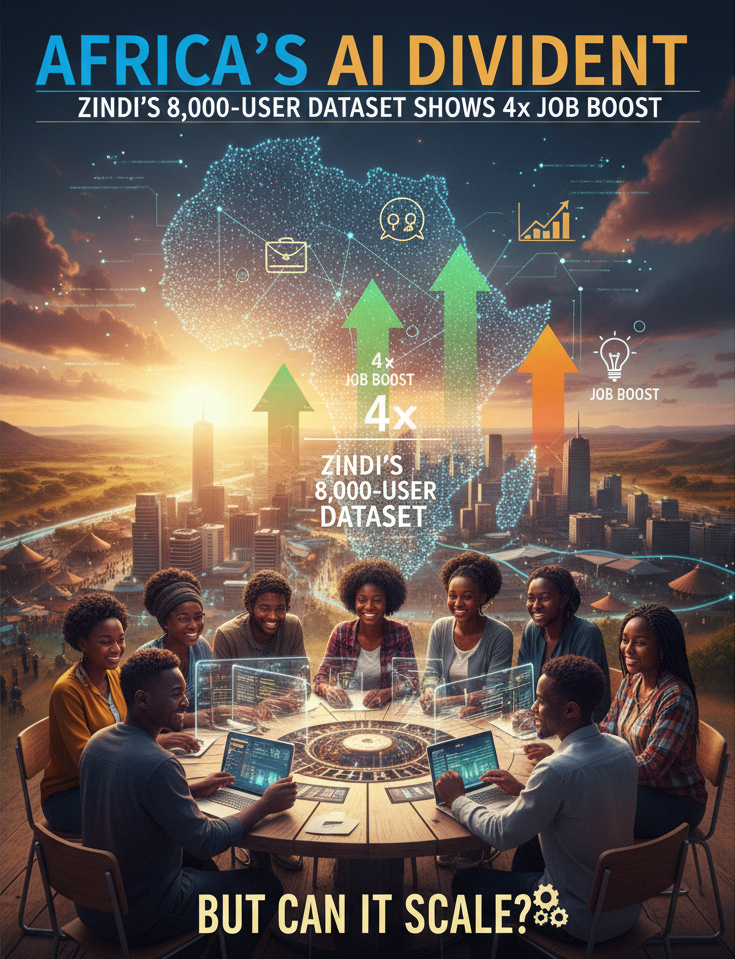Africa’s AI Dividend: Zindi’s 8,000-User Dataset Shows 4× Job Boost, but Can It Scale?
Zindi’s new report on 8,000 Kenyan users shows 1 in 5 secured career shifts, 80% progressed with full profiles, and 4+ challenges made youth 4× likelier to find jobs. For markets, this signals a scalable AI labor pool reshaping outsourcing and credit risk.

Kenya’s new Zindi employability report, unveiled during the UN General Assembly, offers more than a local skills success story—it signals a potential turning point in how frontier economies build AI-era human capital. The report analyzed career outcomes for over 8,000 Kenyan users and found that nearly 1 in 5 (≈ 20 %) experienced a career change after participating in AI/data challenges. Among those who fully completed their profiles (versus those who did not), more than 80 % achieved “professional progress,” whereas just ~3 % of users with incomplete profiles did so. Completing four or more challenges made participants four times more likely to secure employment, while collaborating in teams tripled placement odds. Even completing a single learning course via the platform boosted employability threefold.
Kenya’s broader labor market context makes these figures critical. The Kenya Labour Market Profile (2024/2025) reports an overall unemployment rate of 5.6 %, with 81 % of non-agricultural employment in the informal sector. Among youth, the challenge is acute: those aged 15–34 account for 84 % of all unemployed persons. Earlier data show unemployment for 20–24 year-olds at 16 %, compared to 5.3 % overall. The ICT sector contributes about 4.5 % of wage employment, tying directly into Kenya’s ambitions to become a BPO hub. At the same time, a recent assessment suggests 65 % of hard skills demanded in Kenyan jobs are now at risk of automation. Each year, nearly 800,000 young Kenyans enter the job market, often without the skills needed for evolving labor demand. Across Africa, about 13 million youth are formally unemployed and up to 60 million are neither in work nor training (NEET).
For global markets, the implications are significant. Corporations that have long concentrated outsourcing in India or Eastern Europe are seeking to diversify their supply chains. Companies such as Accenture (ACN), Cognizant (CTSH), and IBM (IBM) could look to Kenya and its peers as cost-competitive alternatives for analytics and back-office talent. Lower training frictions, combined with documented employability conversion rates, shift cost structures for these global service providers. Cloud platforms are positioned to benefit as well: Amazon (AMZN), Microsoft (MSFT), and Alphabet (GOOGL) are already investing in Africa’s digital infrastructure. Rising demand for training, compute, and data storage creates direct tailwinds for AWS, Azure, and Google Cloud earnings.
The EdTech and venture capital angle is equally important. Investors in scalable education-to-employment models will view Zindi’s 20 % career-change benchmark as a quantifiable proof point. That could accelerate regional funding rounds and even open IPO ambitions for Africa-based digital training ventures. Global tech investors like Prosus (PRX.AS) and Naspers (NPN.JO), which have historically bet on emerging market platforms, could find new entry points in the AI employability ecosystem.
Sovereign debt markets should not ignore these signals. Kenya’s eurobonds (KENINT) remain sensitive to fiscal credibility and youth unemployment is a core variable in long-term risk pricing. Demonstrable labor absorption pipelines tied to digital skills can mitigate social instability risk, improving Kenya’s macro profile and possibly compressing spreads over time. The World Bank and IMF’s policy assessments have repeatedly flagged youth unemployment as a structural risk; initiatives that measurably shift employment outcomes provide a counterweight narrative that markets will monitor closely.
Consumer-facing sectors reinforce the economic multiplier. Higher youth employability translates into incomes that expand purchasing power, directly benefiting multinationals such as Coca-Cola (KO) and Procter & Gamble (PG), while increasing transaction volumes for financials like Equity Group (EQTY.NR), KCB Group (KCB.NR), and Safaricom (SCOM.NR). Telcos such as MTN Group (MTN.JO) also stand to gain from higher data consumption, while mobile money usage—already processing billions annually—scales with digitally employed youth.
Markets, however, must price in caveats. The Zindi dataset may suffer from selection bias: participants with internet access, baseline education, and higher motivation are naturally more likely to succeed. The scalability question remains open: can similar results be replicated in rural areas with weak connectivity? And critically, labor demand must expand in tandem. Without sufficient absorption capacity in sectors like fintech, logistics, telecom, and public sector analytics, skills pipelines risk bottlenecking.
Even so, the trajectory is difficult to ignore. Kenya is not just showcasing digital ambition; it is piloting a measurable, data-backed employability model in the AI era. For global capital, this is not a footnote in frontier market development—it is an early signal of how Africa could reconfigure the global supply of AI and data talent. The knock-on effects touch outsourcing strategies, sovereign credit pricing, consumer markets, and multinational earnings. For investors scanning for frontier market signals, Kenya’s AI employability experiment is more than a local story; it is a metric-driven trend that global markets should track closely.





